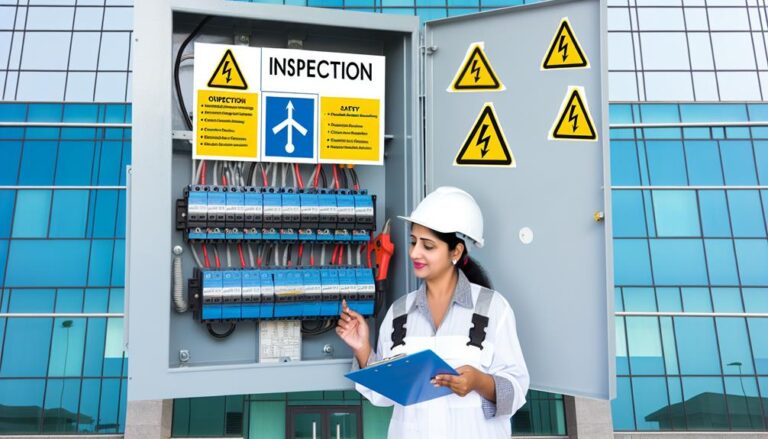Sustainable Electrical Practices for Commercial Spaces
Are you tired of the traditional and wasteful electrical practices in commercial spaces? It’s time to switch to sustainable solutions that not only save energy but also reduce your carbon footprint.
From energy-efficient lighting solutions to smart building management systems, there are several innovative options available for you to explore.
But that’s not all! By integrating renewable energy sources, investing in power-saving equipment and appliances, and even setting up electric vehicle charging infrastructure, you can take your sustainability efforts to the next level.
So, are you ready to transform your commercial space into an eco-friendly haven?
Key Takeaways
- Energy-efficient lighting solutions such as LED lights and motion-activated lighting can significantly reduce energy consumption and lower costs.
- Implementing smart building management systems can optimize energy usage, improve occupant comfort, and identify areas of inefficiency.
- Integrating renewable energy sources into commercial spaces can reduce reliance on traditional power grids, lower costs, and contribute to environmental sustainability.
- Power-saving equipment and appliances, such as energy-efficient devices and smart power strips, can help decrease electricity usage and carbon footprint in commercial spaces.
Energy-Efficient Lighting Solutions
Are you looking for energy-efficient lighting solutions for your commercial space? If so, you’ve come to the right place. In today’s world, where sustainability is a top priority, it’s essential to opt for lighting options that not only save energy but also reduce costs and promote a sense of freedom.
Energy-efficient lighting solutions offer a multitude of benefits for your commercial space.
LED lights are at the forefront of energy-efficient lighting technology. These lights use significantly less energy than traditional incandescent bulbs, making them an ideal choice for any commercial setting. LED lights also have a longer lifespan, reducing the need for frequent replacements and maintenance. Moreover, they emit less heat, which helps to lower cooling costs, especially during warm summers.
Another option to consider is motion-activated lighting. By incorporating sensors that detect movement, you can ensure that lights are only activated when necessary. This not only saves energy but also provides a sense of freedom and convenience for employees and customers alike.
Lastly, daylight harvesting systems are gaining popularity in commercial spaces. These systems use sensors to detect natural light levels and adjust artificial lighting accordingly. By optimizing the use of natural light, you can reduce energy consumption and create a more pleasant working environment.
Smart Building Management Systems
Smart building management systems revolutionize the way commercial spaces are managed, offering advanced technology and automation for efficient operations. These systems integrate various building components, such as lighting, HVAC, security, and occupancy sensors, into a centralized control platform. By collecting and analyzing real-time data, smart building management systems optimize energy consumption, reduce costs, and enhance occupant comfort.
One key feature of smart building management systems is the ability to monitor and control energy usage. Through the use of advanced metering and monitoring tools, these systems provide valuable insights into energy consumption patterns, allowing facility managers to identify areas of inefficiency and implement targeted energy-saving measures. Additionally, automated controls enable real-time adjustments based on occupancy levels, weather conditions, and other factors, ensuring that energy is only used when and where it’s needed.
Another advantage of smart building management systems is their ability to improve occupant comfort and productivity. By continuously monitoring indoor environmental conditions, such as temperature, humidity, and air quality, these systems can automatically adjust HVAC settings to maintain optimal comfort levels. Furthermore, smart building management systems can provide occupants with personalized control over lighting and temperature settings, empowering them to create a workspace that suits their individual preferences.
Renewable Energy Integration
Renewable energy integration in commercial spaces involves the incorporation of sustainable energy sources to reduce reliance on traditional power grids. By implementing renewable energy technologies, businesses can contribute to a greener future while also benefiting from various advantages.
Here are three key benefits of integrating renewable energy in commercial spaces:
- Cost savings: Renewable energy sources, such as solar panels and wind turbines, can generate electricity at a lower cost compared to traditional power grids. By harnessing these sources, businesses can reduce their energy bills and allocate the saved funds towards other areas of their operations.
- Environmental impact: Utilizing renewable energy helps reduce greenhouse gas emissions, mitigating the negative impact on the environment. By transitioning to sustainable energy sources, commercial spaces can actively contribute to combating climate change and promoting a cleaner and healthier planet.
- Energy independence: Integrating renewable energy allows businesses to become less reliant on external power grids. This independence provides a sense of freedom and stability, as commercial spaces can generate their own electricity and mitigate the risks associated with power outages or fluctuating energy costs.
Power-Saving Equipment and Appliances
When it comes to reducing energy consumption in commercial spaces, one effective strategy is the implementation of power-saving equipment and appliances. By choosing energy-efficient devices, you can significantly decrease your electricity usage and lower your utility bills. Additionally, using power-saving equipment not only reduces your carbon footprint but also extends the lifespan of your appliances.
To illustrate the benefits of power-saving equipment and appliances, consider the following table:
| Equipment/Appliance | Energy Efficiency Rating |
|---|---|
| LED Lighting | A+ |
| Energy Star HVAC | A++ |
| Smart Power Strips | A |
| Occupancy Sensors | A |
| Programmable Thermostats | A+ |
LED lighting, for instance, provides superior energy efficiency with an A+ rating. Energy Star HVAC systems are also highly efficient, with an A++ rating. By installing smart power strips, you can prevent energy wastage from idle electronics. Occupancy sensors and programmable thermostats further optimize energy usage based on occupancy patterns and desired temperatures, respectively.
Electric Vehicle Charging Infrastructure
To efficiently accommodate electric vehicles, commercial spaces should have a well-designed and accessible electric vehicle charging infrastructure. Here are three key considerations for implementing a sustainable and effective charging infrastructure:
- Location: Strategically place charging stations in convenient and high-traffic areas of your commercial space. This ensures that electric vehicle owners can easily access and utilize the charging infrastructure. Consider installing charging stations near entrances, parking lots, and other frequently visited areas. Additionally, providing clear signage and wayfinding systems can help users locate the charging stations effortlessly.
- Capacity: Determine the appropriate number of charging stations based on the size and demand of your commercial space. Assess the number of electric vehicles likely to be present at any given time and ensure that there are enough charging points to meet this demand. Providing a variety of charging levels (such as Level 2 and DC fast charging) can accommodate different types of electric vehicles and their charging needs.
- Compatibility: Select charging equipment that supports various charging standards and connectors, ensuring compatibility with a wide range of electric vehicles. This flexibility allows electric vehicle owners to charge their vehicles regardless of the charging infrastructure in place. It’s also important to consider the future demands of electric vehicles and invest in scalable infrastructure that can be easily expanded or upgraded as needed.







